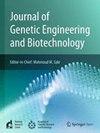Genetic diversity and population structure analysis in Asparagus officinalis
IF 2.8
Q3 Biochemistry, Genetics and Molecular Biology
Journal of Genetic Engineering and Biotechnology
Pub Date : 2025-04-26
DOI:10.1016/j.jgeb.2025.100491
引用次数: 0
Abstract
Asparagus cultivars grown worldwide are thought to have originated from a limited genetic base, however, selection has resulted in variation for climatic adaptation and other traits. Understanding genetic diversity of the crop is important to guide breeding decisions. The objectives of this research were to identify SNPs among 64 cultivated lines from different geographic areas and assess genetic variation, population structure and linkage disequilibrium. More than 55,000 SNPs were identified by GBS and subjected to filtration for minor allele frequency and missing data, resulting in 12,886 markers for all subsequent analysis. Markers exhibited a wide range of Expected Heterozygosity (He), Polymorphic Information Content (PIC) and Observed Heterozygosity (Ho) with mean values of 0.370, 0.310, and 0.450 respectively. Population STRUCTURE analysis indicated that the 64 lines were grouped into two, four, seven, and nine subpopulations. For K = 4, four distinct groups were defined: (1) New Zealand, New Jersey, France, and California; (2) Canada; (3) China, The Netherlands, and Germany; and (4) England, Denmark, Spain, Turkey, and India. The results were further confirmed by PCA, and a phylogenetic tree. LD declined rapidly with an increase in physical distance. A considerable amount of genetic diversity was observed, despite previous suggestions that asparagus cultivars may have originated from one open-pollinated population.
芦笋遗传多样性及群体结构分析
世界各地种植的芦笋品种被认为起源于有限的遗传基础,然而,选择导致了气候适应和其他性状的变化。了解作物的遗传多样性对指导育种决策很重要。本研究的目的是鉴定来自不同地理区域的64个栽培品系的snp,并评估遗传变异、群体结构和连锁不平衡。GBS鉴定了超过55,000个snp,并对次要等位基因频率和缺失数据进行了过滤,结果为所有后续分析提供了12,886个标记。预期杂合度(He)、多态信息含量(PIC)和观察杂合度(Ho)的平均值分别为0.370、0.310和0.450。种群结构分析表明,64个株系可分为2、4、7和9个亚种群。当K = 4时,定义了四个不同的组:(1)新西兰、新泽西、法国和加利福尼亚;(2)加拿大;(3)中国、荷兰、德国;(4)英国、丹麦、西班牙、土耳其和印度。通过主成分分析和系统发育树分析进一步证实了这一结果。LD随物理距离的增加而迅速下降。尽管先前认为芦笋品种可能起源于一个开放授粉的种群,但仍观察到相当数量的遗传多样性。
本文章由计算机程序翻译,如有差异,请以英文原文为准。
求助全文
约1分钟内获得全文
求助全文
来源期刊

Journal of Genetic Engineering and Biotechnology
Biochemistry, Genetics and Molecular Biology-Biotechnology
CiteScore
5.70
自引率
5.70%
发文量
159
审稿时长
16 weeks
期刊介绍:
Journal of genetic engineering and biotechnology is devoted to rapid publication of full-length research papers that leads to significant contribution in advancing knowledge in genetic engineering and biotechnology and provide novel perspectives in this research area. JGEB includes all major themes related to genetic engineering and recombinant DNA. The area of interest of JGEB includes but not restricted to: •Plant genetics •Animal genetics •Bacterial enzymes •Agricultural Biotechnology, •Biochemistry, •Biophysics, •Bioinformatics, •Environmental Biotechnology, •Industrial Biotechnology, •Microbial biotechnology, •Medical Biotechnology, •Bioenergy, Biosafety, •Biosecurity, •Bioethics, •GMOS, •Genomic, •Proteomic JGEB accepts
 求助内容:
求助内容: 应助结果提醒方式:
应助结果提醒方式:


